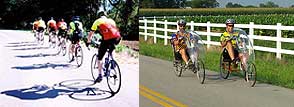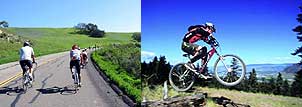
SCOR PRODUCTIONS KNEESAVERS PEDAL ADAPTERS

By Charlie Coyne
While it is true that I have two of the most studly knees around, their beauty had sadly only been skin deep earlier this year.
On longer rides, especially on some recumbents, unfair pain had been limiting my speed, distance and endurance.
The problem was especially bad when putting miles on the Longbike's Slipstream, reviewed recently in RTR issue #13. I had really began to wonder whether I would be able to complete the century that were in the plans for this season. As wonderfully comfortable as the Slipstream rides, my knees were just about shot after the first 15-20 miles.
Then the pain around the outboard diameter of my kneecaps would become to sharp to allow enjoyable riding. I have always adjusted my clip-less pedals to allow the maximum amount of toe-out, but the limiting factor was always the interference between the crank arm and my heels.
Perhaps it's was the unique geometry form the Longbike's crankarm height, crankarm length, seat height/angle and seatback angle, combined with my own hip/leg geometry that really aggravated the apparent misalignment of my knees, but the problem had escalated to the point that I was whining about it to my riding buddies, so you know how serious it really was.

It's funny how you can look at the solution to a problem for a long time without actually seeing it. In my case, I had seen the Kneesavers ads in RTR many, many times in past issues. One day, while reading the ad again it finally dawned on me that they might help me with my knee pain plight.
A quick look at the website revealed much (www.bikescor.com).
Kneesavers are simple. Machined and case-hardened from billets of stainless steel, they fit between the crank arms and the pedals. Sold in pairs or individually, Kneesavers Pedal Adapters come in 20mm, 25mm and 30mm widths. The standard width is 20mm, which weights 6.1 ounces per pair. For all of you weight warriors, titanium Kneesavers are also available, in 20mm length only, and they are more costly.

The standard Kneesaver adapter 's additional 20mm. spacing moves the pedals away from the crank arms up to 25 degrees of toe-out before the riders heels hit the crank arms. Most fixed and floating-pedal systems allow a maximum of 4-5 degrees of toe out before heel/ crankarm interference occurs. Up to 45 degrees of toe-out is possible with the longer 30mm. Kneesavers.
A phone call to the company's toll free number- 1-800-548-4447- had a pair of 20mm.
stainless Kneesavers on the way to me after a charge of $45.00 plus $3.00 for shipping. Within a few days the package arrived via US mail. As is evident in the photo, Kneesavers are really quite simple. What isn't evident is how finely they are precision-machined, likely to closer tolerances than many pedals on the market. At first blush, it seemed that $45.00 was a lot for some simple pedal spacers, but hey, the money was already spent so onto the bike they went. Besides, after enduring such a lengthy period of riding pain, I was just about the point where money was no object. It's hard to know what to say about Kneesavers without sounding like over the top hype.
One of life's never-failing truisms is that if something sounds too good to be true, it is. I am particularly skeptical when it comes to health claims. Magic mumbo-jumbo that help you melt off fat, gain weight, improve your memory, increase size and stamina, the world is full of them and the people that buy them. My wife insists that I take my vitamins each day, so I do, but I avoid so much as an aspirin and the like unless I am really suffering. I've been blessed with pretty good health so far, without using a lot of additives.
So when I first clipped into the SPD pedals after the installation I was amazed. Without even so much as turning a pedal, I could feel a profound difference while I braced the bike against the workbench. My hips, knees and feet felt perfectly "lined-up" and centered the instant the pedals clicked in. A quick trip down the street on the Slipstream had me thinking that we might be on to something here.
Even without adapters, a quick spin would not have incited the knee pain, so it wasn't the absence of pain that had me excited. I guess it was the feel that everything was finally aligned correctly, and the prospect of long rides was alive once again. I put several hundred miles on the slipstream after equipping it with the Kneesavers. I wanted to make sure that they were the "real deal" before writing an evaluation.
To be honest, the pain did return in the first few long rides, but it took longer and longer for it to occur, and it was certainly less severe. I believe that a good part on the continued pain was from the inflammation that just took some time to heal. I also adjusted the cleats on my shoes to the position closest to the heal which also seemed to help.
Over time, my legs have actually become stronger from being able to pedal without the pain. I think that I had been unconsciously contorting my knees, ankles and feet to avoid and alleviate the pain. With the kneesavers, I could now apply full pressure throughout the powerstroke without fear, and I could feel muscles in my legs firing that I hadn't felt before. Longer and longer rides became possible, climbing hills was easier and my overall speeds picked up. I was fully confident and ready for the first century of the season, the Solvang Century in Solvang, California. My knee problems were most pronounced on recumbents. On upright bike, it would take the better part of a century about the 60-70 mile mark before I would have any trouble with my knees. So far, I have not ridden an upright with the Kneesavers, so I can't report about their effectiveness in such an installation. But that's OK with me. The Kneesavers have been the best $48.00 riding accessory I have bought in many years. I may give some thought to a pair of $100.00 titanium units.
Contact: SCOR Productions at:
P.O. Box 2466
Fallbrook, CA 92028
Tel: 800.548.4447
Fax: 760.728.0571

